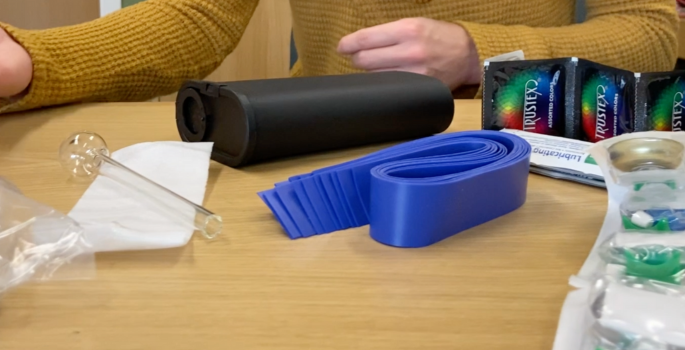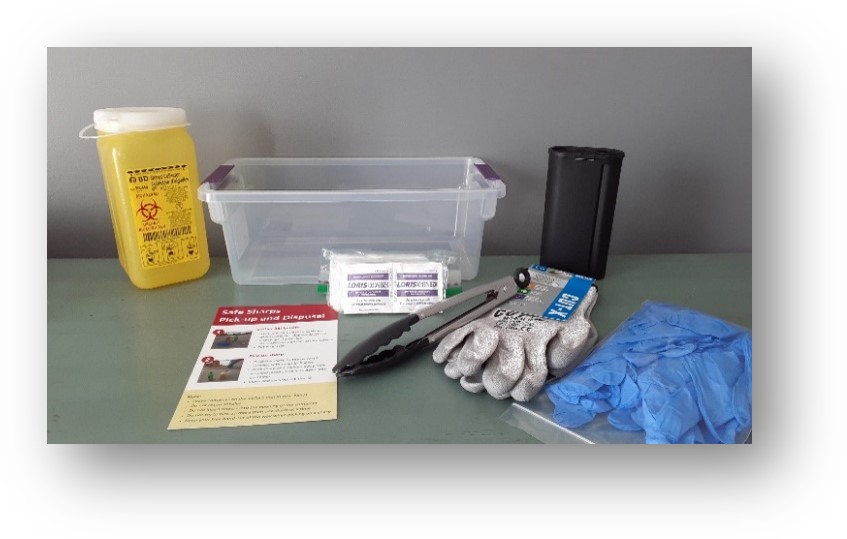Community safety. That's the point!
Improperly discarded needles, glass pipes and other sharps have been identified as a serious concern in our community.
Most people in our communities dispose of used sharps properly, but sometimes sharps can be found in parks, beaches, sidewalks, trails, etc.
In effort to promote community safety, we collaborate with community partners to install community sharps bins, offer free public education on how to safely handle and dispose of a sharp, and provide biohazard containers for clients to safely dispose of used needles and other harm reduction equipment.
Keeping our region safe is everyone's responsibility.
Knowing how to safely pick up and dispose of a sharp can help to prevent the spread of diseases such as HIV and hepatitis. Do your part by learning about sharps, and what to do if you find one in your community.
If you find a sharp...
Review and follow the steps for safe handling and disposing of a sharp.
You can use a hard-sided container from home (such as a pop bottle or laundry detergent container with a lid), or pick up a free biohazard container from a participating pharmacy.If the sharp is on public property and you are not comfortable handling it, please call your municipality's Public Works department.
Frequently Asked Questions
What is a sharp? |
|
A sharp is an object that has the ability to puncture or cut someone or something. Examples include:
|
What safe sharps disposal options are available in the Health Unit region? |
|
Once a sharp has been safely collected in a hard-sided container (e.g., biohazard container, pop bottle, laundry container with a lid), it can be dropped off at a number of places across the Nipissing and Parry Sound districts. These include:
|
Where can I get additional materials to support safe sharps disposal? |
|
Visit our office in North Bay or Parry Sound from April 14-25, 2025, for a free sharps handling and disposal kit! Kit pick-up runs from 8:30 a.m. to 4:30 p.m. this week and is open to individuals, businesses, agencies and municipalities while supplies last. Tongs, disposable gloves, and disinfectant wipes are optional and may be purchased at a local retail store. When picking up a sharp, you will need a hard-sided, puncture-resistant container. You can get a biohazard container at participating pharmacies, or use an empty pop bottle or laundry detergent container instead. For more information on where to purchase or pick-up biohazard containers, please contact harm.reduction@healthunit.ca. |
What if I accidentally injure myself with a sharp? |
|
There is a very low risk of blood-borne infections from a sharp injury. Your risk of getting HIV or Hepatitis C from a needle stick injury depends on a number of factors, such as:
Someone who does get injured by a used sharp should:
If the incident happened while working, contact your occupational health department and report the incident accordingly. |
Why does the Health Unit work with individuals who use needles? |
|
We operate on the harm reduction principle of providing clients with an adequate amount of sterile needles to meet their requirements for safe injecting. The main goal of this program is to prevent the spread of communicable diseases, primarily HIV and Hepatitis C, and minimize the risks associated with substance use in the greater community. We educate all individuals who use on how to dispose of needles safely and the risks of failing to do so. We provide them with sharps containers and information on various disposal locations, and also encourage them to return their supplies directly to the program. |
If you would like more information, or have questions about sharps in the community, please contact us via email at harm.reduction@healthunit.ca.
Community Safety. That's the Point! Campaign Materials

Posters |
EnglishFrench |
Social Media |
English ImagesFrench Images |
Videos |
EnglishFrench |

Drug-Related Stigma
Some language has become so common that we often don't realize its impact. Learn the four guidelines to non-stigmatizing language and find other ways you, your workplace and community can help reduce the stigma around drug use.
Information for Organizations and Workplaces
What do I include in a safe sharps handling and disposal kit? |
|
Putting together a safe sharps handling and disposal kit is inexpensive and easy to do. It is recommended that a safe sharps handling and disposal kit include the following items:
|
Purchasing Biohazard Containers |
| Biohazard containers come in a wide range of sizes, styles, and forms. Containers are relatively inexpensive and can be purchased from a number of distributors. For more information on where to purchase or pick-up biohazard containers, please contact harm.reduction@healthunit.ca |
My organization/workplace has sharps containers in their bathrooms. Where can I dispose of the biohazard containers once they are full? |
|
For organizations/workplaces that require regular sharps pick-up and disposal, connect with us or your municipality for information about local disposal options. Organizations/workplaces may also connect with one of the following companies to set-up an account for regular disposal services:
|
Where can I get training for my staff? |
|
Training is available online at no cost. Contact harm.reduction@healthunit.ca for an upcoming Safe Sharps Handling and Disposal training! |
For additional information, or questions about sharps in the community, please contact us via email at harm.reduction@healthunit.ca.





